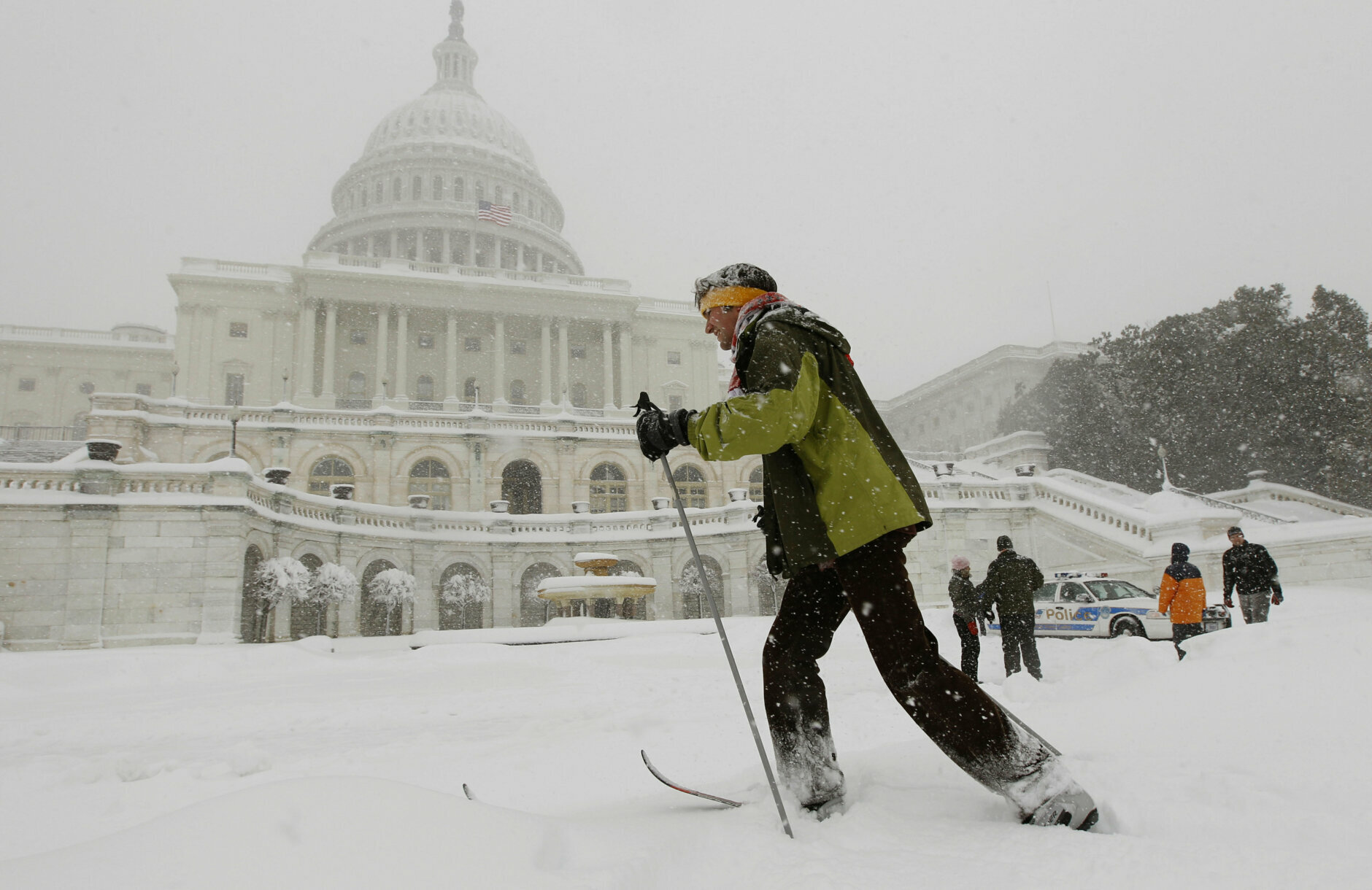| What: | Telework Enhancement Act |
| When: | Extreme winter weather in February 2010 led to the passage of a bill months later, aiming to strengthen telework opportunities and guardrails. |
| Why it matters: | More than a decade later and following the COVID-19 pandemic, agencies have been constantly reassessing what their telework posture should be. Though it started as a response to extreme weather events, the 2010 Telework Enhancement Act eventually overhauled how agencies approached their long-term workforce strategies for years to come. |
Politics
A 2010 winter storm overhauled the government’s approach to telework for more than a decade


In February 2010, a “Snowmageddon” slammed the eastern United States, causing a dayslong stretch of unprecedented, blizzard-like conditions that piled up 30 inches of snow in some regions. Countless flights were canceled and roads were blocked. The National Oceanic and Atmospheric Administration reported that the storm killed 41 people, and over 200,000 homes and businesses went without power for days.
Amid all the chaos that came from the record-breaking storm, the 2010 Snowmageddon spurred further conversations in Congress about the need to use all means necessary to keep federal agencies up and running, even in the worst scenarios possible.
Lawmakers had already been working for a few years on legislation to expand the use of telework in the federal government. Many argued that expanding telework for federal employees would ensure they could maintain critical services to the public, regardless of external conditions.
But it wasn’t until 2010 — spurred by the major snowstorm — that a bipartisan bill called the Telework Enhancement Act began gaining more attention.
“[Snowmageddon] really pushed this issue of, what do you do to maintain continuity of operations, particularly for critical agencies, when people can’t get to their normal workplace?” said former Rep. John Sarbanes (D-Va.), an original co-sponsor on the 2010 bill. “That theme, the continuity of operations, was helping to, I think, deepen the interest on the part of legislators in telework.”
The challenges agencies faced during Snowmageddon made it clear there was a need to have baseline telework policy to ensure agencies’ continuity of operations. If there were regional shutdowns of federal buildings, for instance, agencies had to find a way to continue working — and in many cases, lawmakers said that necessitated telework.
The late Sen. George Voinovich (R-Ohio), a co-sponsor of the bill, argued back in 2010 that “advancements in technology mean employees will expect to be able to work at any time from any place, as evidenced by the thousands of federal employees who worked from home during last winter’s snowstorms in Washington, D.C. This bill will expand telework programs for federal employees and ensure the government keeps running during weather events or emergencies.”
It took most of the year to move the legislation through Congress, but by December 2010, lawmakers had reached an agreement on the Telework Enhancement Act. The bill intended to broaden the use, define the guardrails and measure the impacts of telework across the federal government. President Barack Obama signed the bill into law on Dec. 9.
The Telework Enhancement Act specifically required the Office of Personnel Management to create governmentwide telework guidance. OPM then tasked agencies with developing their own internal policies for teleworking employees — figuring out who was eligible for it, and what frequency of telework made sense. Each agency also had to designate a telework managing officer and offer telework training to staff members.
As a result of the legislation, OPM began compiling governmentwide data on telework, covering how much employees were using the flexibility, and what its impacts were not only on continuity of operations, but also productivity, cost savings, workforce retention and more.
Proponents saw telework in government as more than just a perk for federal employees. It was a way to ensure critical services continue to be delivered, generate cost savings on federal office space, improve employee recruitment and retention in competition with the private sector, and add more efficiencies to agency workflows.
“It was about realizing that there’s a strong and durable hybrid model that you can build. That means you’re maximizing what it looks like to be on-site, in the office, in the traditional workplace on the one hand — but at the same time, allowing telework and remote work to bring the productivity opportunity that it represents into the equation,” Sarbanes said. “There was a sense that we could find a new kind of diversified, hybrid workplace, that would contribute to productivity.”
Early challenges, opportunities
After a few years, the effects of the Telework Enhancement Act appeared promising. In 2013, the Government Accountability Office reported that following the 2010 law’s requirements, the expanded availability of telework was helping agencies recruit and retain employees, as well as save on real estate costs and reduce energy consumption.
And in a 2015 report to Congress, then-acting OPM Director Beth Cobert said agencies were continuing to make “enormous” progress in their implementation of the telework legislation.
“Agencies have not only met basic statutory requirements, but have also taken steps to strategically leverage telework in support of critical goals,” Cobert said. “There is mounting and encouraging evidence to suggest that the vision that drove the act is increasingly becoming reality.”
Of course, there were barriers and challenges to the law’s implementation as well. Agencies expressed concerns about IT-related costs of telework, such as purchasing laptops for at-home work. Some agencies worried about telework options raising issues of perceived fairness between employees. Others reported difficulties with managers who were resistant to increases in telework for their employees.
Agencies at the time were also struggling to measure the effects of telework, GAO said. There were some gaps in the data, stemming in part from agencies’ lack of experience measuring the impacts of telework.
“That, plus a lack of baseline data, may be dissuading agencies from focusing attention on telework goals,” GAO wrote in 2015.
Following those early challenges, however, GAO ultimately closed its recommendations to OPM on improving data collection, confirming that the changes had been implemented.
Still, in the years to follow, data on telework and remote work would become a central point of the rising disagreements over the future of the federal workplace.
Telework law collides with COVID-19
While initially a response to extreme weather events, the 2010 Telework Enhancement Act also prepared agencies to continue services during a much different and unprecedented type of disaster: the COVID-19 pandemic.
By the height of pandemic, agencies had already spent years developing and fine-tuning their telework and remote work policies. They had ironed out a lot of the early wrinkles following the 2010 legislation, while working to improve their collection of telework data.
So in March 2020, when the White House asked agencies to move to a maximum telework posture, many were able to do just that.
“It just stands to reason that if you had invited or required agencies to be more intentional about telework and think about how to design it inside their own structures — that exploration in and of itself, combined with actual practice for a number of years, would position the agency more strongly to respond in the pandemic moment,” Sarbanes said.
But the ability to pivot to a maximum telework posture also largely depended on the agency. Agencies who had leaned more into telework in the years leading up were more effective, while agencies who had been slower to incorporate telework struggled more.
“For agencies who didn’t have a tremendous population of workers who were set up to telework, who maybe hadn’t invested in laptops, that certainly became a real challenge,” Jackie Maffucci, former OPM deputy director for congressional, legislative and intergovernmental affairs, said in an interview. “Agencies really had to overcome that — as well as this idea of turning what was a volunteer program now into almost a mandate for individuals who were required to work from home because of the emergency.”
Later on, telework data also showed agencies increased their flexibilities during the pandemic, as the total number of telework-eligible feds gradually increased. During COVID-19, the federal workforce crossed a threshold, with just over half of employees becoming telework-eligible governmentwide.
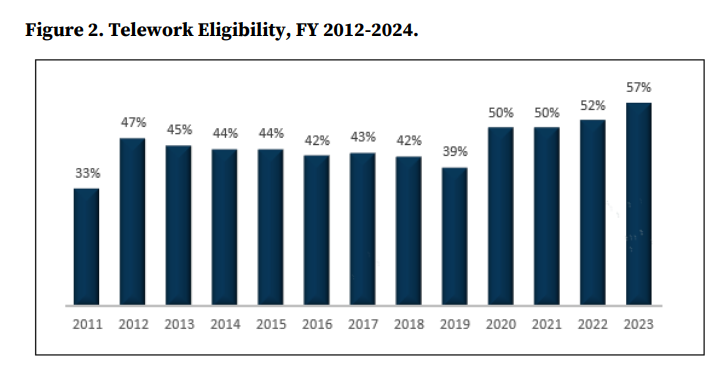 Telework eligibility in the federal workforce, 2012-2024. Source: Office of Personnel Management 2024 report to Congress on status of telework in the federal government.
Telework eligibility in the federal workforce, 2012-2024. Source: Office of Personnel Management 2024 report to Congress on status of telework in the federal government.
That meant even at the height of the pandemic, about half of the entire federal workforce was working entirely on-site given the public-facing nature of their jobs. But the maximum telework posture during 2020 still created rippling consequences for the federal workforce for years to come.
Post-pandemic transformation
The COVID-19 pandemic revealed plenty of lessons learned about the future of work, but also left many questions about how agency telework policies would emerge on the other side of the national emergency.
In 2021, the Biden administration’s OPM issued new telework guidance, outlining a future of work that hinged on “hybrid work.” The guidance encouraged agencies to more deeply incorporate telework and remote work into their long-term workforce plans. At the time, OPM said integrating telework for the long run would help improve recruitment, retention and cost savings.
“The COVID-19 pandemic forced changes to the workplace. Many employees learned how to perform the functions of their job in a new way during a difficult time, meeting the challenges head-on. Agencies demonstrated that they have been able to carry out their missions effectively,” OPM wrote in the 2021 guidance. “Accordingly, agencies now have an opportunity to revisit how they were operating prior to the pandemic and leverage lessons learned during the pandemic to integrate telework and remote work into their strategic workforce plans.”
Despite agencies still being able to function throughout the height of COVID-19, the pandemic revealed some challenges in federal telework policies as well. And those challenges unearthed a deep divide in how the future of work should be approached in government.
Some lawmakers, for instance, saw those gaps as an opportunity to build further on telework requirements governmentwide. The 2022 Telework Metrics and Cost Savings Act, a bill introduced by Sarbanes and the late Rep. Gerry Connolly (D-Va.), sought to create stricter data collection and reporting requirements for agencies with teleworking employees. Ultimately, however, Congress failed to pass the bill.
At the same time, many Republicans began blaming the use of telework during the pandemic for lagging services to the public and growing backlogs. Congressional GOP members introduced various bills attempting in one way or another to return the federal workforce to pre-pandemic levels of telework.
As agencies began slowly returning their employees on-site, Republicans’ arguments against telework intensified. The House Oversight and Accountability Committee held multiple hearings in the early years post-pandemic to question federal officials on the use of telework across government.
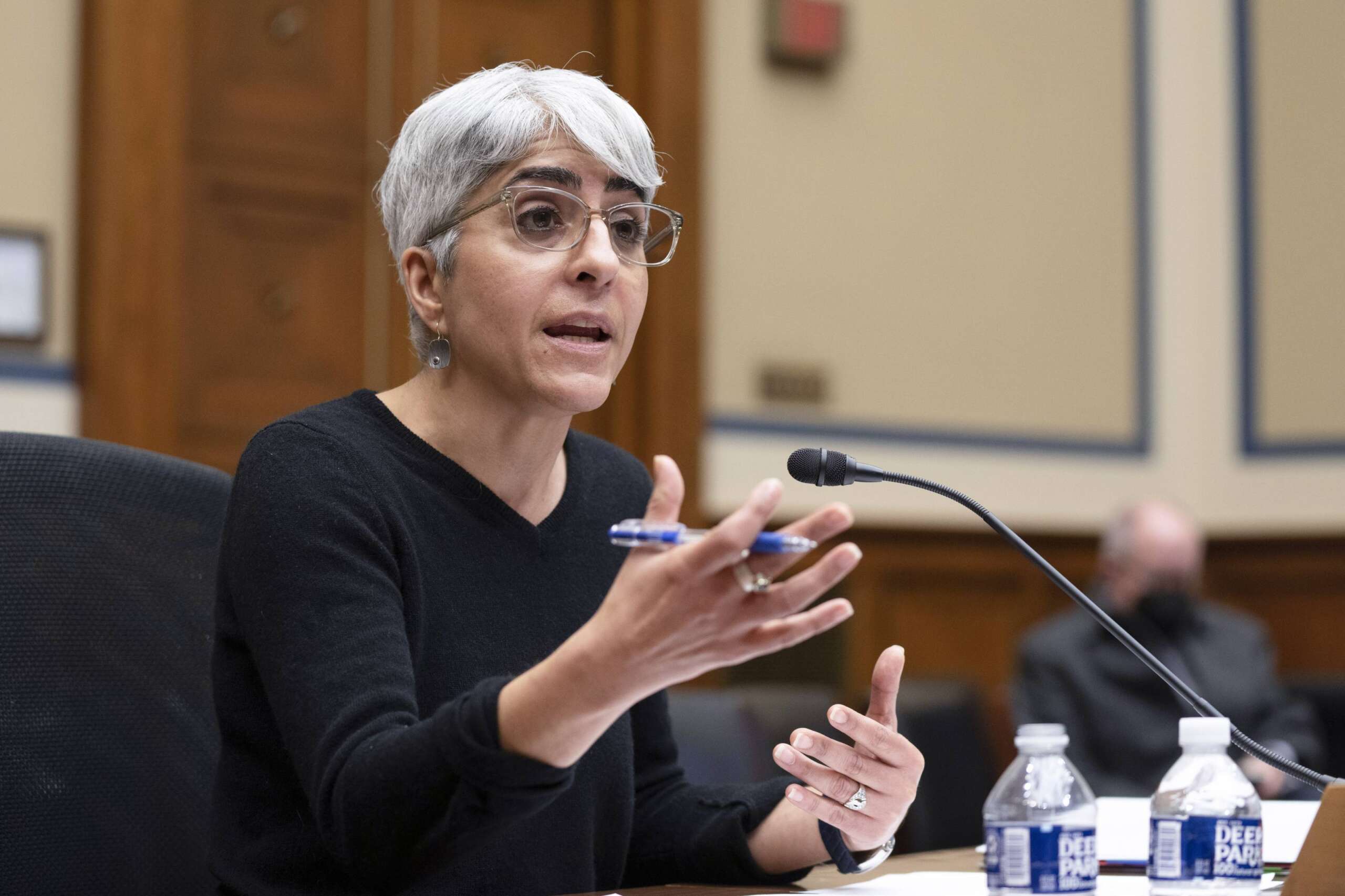 OPM Director Kiran Ahuja testifies before the House Oversight and Accountability Committee during a hearing on OPM, March 9, 2023. (AP/Manuel Balce Ceneta)
OPM Director Kiran Ahuja testifies before the House Oversight and Accountability Committee during a hearing on OPM, March 9, 2023. (AP/Manuel Balce Ceneta)
During a March 2023 hearing, committee Republicans questioned then-OPM Director Kiran Ahuja on what they saw as an inability to provide specific data on telework levels across government. They brought up what would become familiar arguments against federal telework, and pushed for a full return to the office.
Running counter to those arguments, Democrats said telework was a benefit to public service, allowing employees to increase productivity, while also contributing to higher engagement, satisfaction, and recruitment and retention trends.
Biden revisits post-pandemic work arrangements
Federal employees’ workplace arrangements hit another turning point in April 2023, when the Biden administration’s White House urged agencies to require telework-eligible federal employees to report to work on-site 50% of the time.
The Office of Management and Budget, at the time, said agencies were expected to increase “meaningful” in-person work at federal offices, while maintaining telework flexibilities where needed.
“It is the right time for agencies to assess their work environments, reflecting on what they have learned as they build routines for measuring and monitoring organizational health and organizational performance,” then-OMB Director Shalanda Young said.
The White House’s move received pushback from many federal employees who valued the flexibilities telework provided. Many argued that agency telework should not fall to a one-size-fits-all approach, and instead be based on individual agencies’ responsibilities and needs.
For years, federal employees had largely been saying they liked the increased telework during the pandemic. They figured out their “new normal” and didn’t necessarily want to go back to the office for what they saw as a political maneuver. About two-thirds of federal employees said on-site work makes them less productive, according to the results of an April 2024 Federal News Network survey.
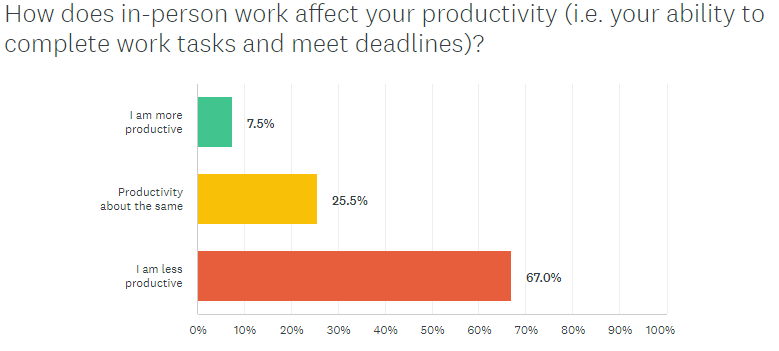 Source: Federal News Network April 2024 return-to-office survey of 6,300 federal employees.
Source: Federal News Network April 2024 return-to-office survey of 6,300 federal employees.
“As we were doing re-entry, there was a recognition that there were some advantages that had come from teleworking, but I think there was also the memory of those growing pains that persisted, and that were at odds,” Maffucci said. “Some of those challenges came to a head, and as we were able to reopen buildings and bring people back into the office, there became this natural inflection point — to what extent should we be fully bringing people back into offices, versus taking advantage of the lessons learned and the benefits that we’ve seen from telework, and applying that in a post-COVID era?”
Across multiple annual telework reports, OPM maintained that using telework flexibilities led to cost savings. On top of reduced spending from fewer commuting and transit needs, agencies were increasingly starting to report “significant increases in cost savings” coming from reduced workforce turnover and lower rent and office space needs, OPM wrote in 2024. The report also showed that agencies had improved their ability to track and measure telework’s impact on productivity.
In the few years following the pandemic, agencies had begun putting together plans to scale back their office space holdings, in light of what they expected to remain a hybrid workforce for years to come.
But at the beginning of 2025, many of those plans were disrupted by a major shift in the government’s telework posture.
Trump orders a full-fledged return-to-office
After more than a year of agencies attempting to meet the Biden administration’s 50% in-the-office expectations, those plans were all but thrown out the window on President Donald Trump’s first day in office.
On Jan. 20, Trump immediately directed all agencies to return teleworking federal employees to the office full-time, and to cancel all remote work and telework arrangements. The order aligned with the anti-telework sentiments many congressional Republicans had been voicing for years.
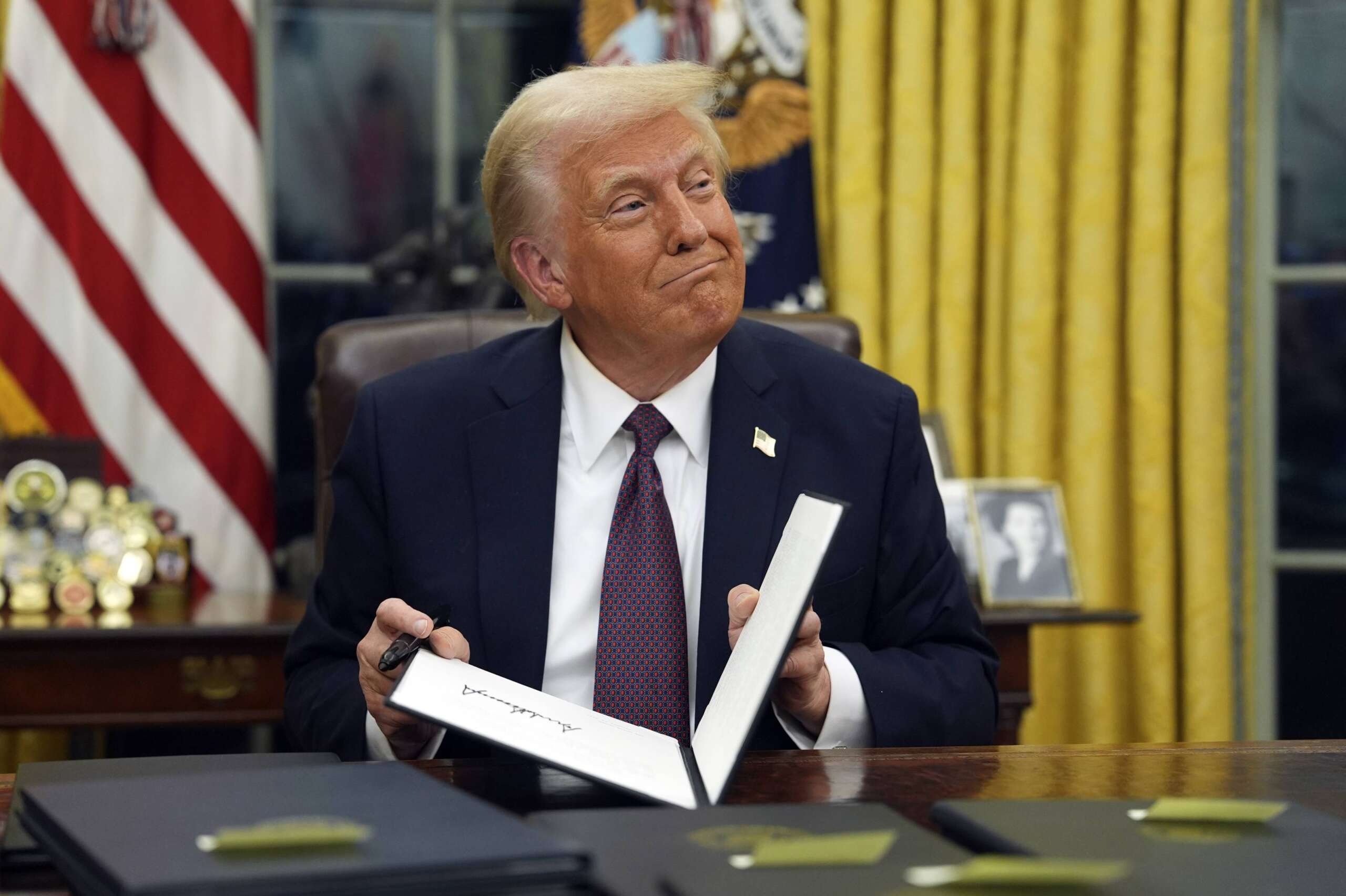 President Donald Trump signs executive orders in the Oval Office of the White House, Jan. 20, 2025, in Washington. (AP Photo/Evan Vucci, File)
President Donald Trump signs executive orders in the Oval Office of the White House, Jan. 20, 2025, in Washington. (AP Photo/Evan Vucci, File)
The Trump administration’s OPM subsequently rescinded much of the previously existing guidance on federal telework, saying it no longer applied given the full return-to-office orders. But now, agencies face a lack of clarity in how they should proceed, according to analysis from GAO. In a June 2025 report, GAO said OPM should issue new guidance, after rescinding the old guidance, so agencies know what to do next.
“If agencies have a remote work posture, they need to assess whether the remote work posture is helping them effectively and efficiently meet mission needs — or make improvements if improvements need to be made,” Dawn Locke, GAO’s director of strategic issues, said in an interview. “And we believe that OPM can provide the guidance that will help with these assessments.”
As agencies began pushing all employees to begin fully on-site work schedules, the speed of the return to the office, coupled with many agencies who had begun scaling down their office space holdings, led to a number of early challenges. Many agencies faced issues like not enough parking, employees working in hallways or packed conference rooms — even running out of office supplies like toilet paper.
By that time, some agencies had already spent years working toward reducing their office space holdings and real estate spending, following an increase of telework and remote work. But after Trump’s return-to-office orders, many of those plans were indefinitely put on hold, GAO found.
“When January 2025 rolled around and there was the order to return to the office on a full-time basis, those agencies stopped reducing space, and they’re currently assessing their mission needs, their staffing needs and the office space needs that they have to determine whether they can reduce office space anymore,” Locke said.
Similar to years of OPM reports, GAO also found largely positive results from telework and remote work flexibilities across government — particularly on recruitment, retention and cost savings. For instance, a 2024 GAO study found that in identical job postings — where one opening is on-site and the other is remote — the remote opening will receive seven times the number of applicants.
“From what agencies have told us, they are likely going to take a hit on recruitment and retention because those workplace flexibilities are no longer available,” Locke said.
Regardless of the government’s current workplace posture, the Telework Enhancement Act is still enshrined in law. With currently limited telework, the legislation may not be doing much for the time being. But more likely than not — whether it’s months or years down the road — agencies are bound to see yet another shift in the federal future of work.
“When it comes to how we design the federal workplace, it’s unfortunate if you let political expediency interfere with good data, best practices and doing the hard work of figuring out what makes sense from a management and operational standpoint,” Sarbanes said. “Certain agencies offer great opportunities for insight and for making sure going forward, we manage this in an objective and sensible way.”
The post A 2010 winter storm overhauled the government’s approach to telework for more than a decade first appeared on Federal News Network.
Politics
President Trump Taps Dr. Ben Carson for New Role — A HUGE Win for America First Agenda
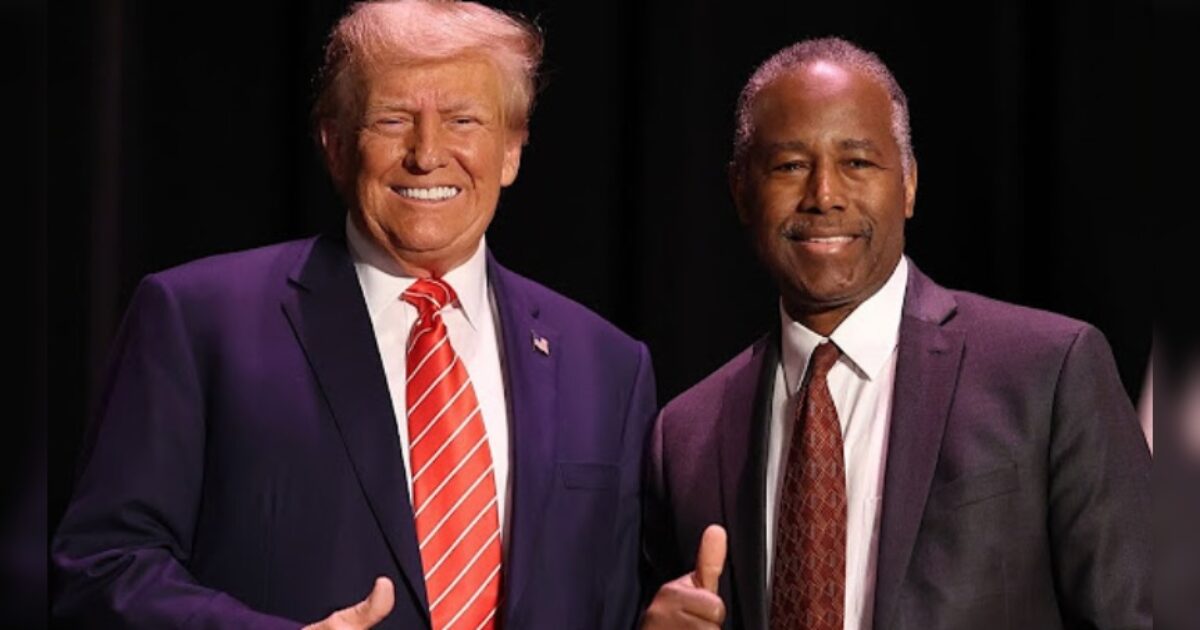
Dr. Ben Carson is the newest member of the Trump administration.
On Wednesday, former Secretary of the Department of Housing and Urban Development, Ben Carson, was sworn in as the national adviser for nutrition, health, and housing at the U.S. Department of Agriculture.
Agriculture Secretary Brooke Rollins shared that Carson’s role will be to oversee Trump’s new Big Beautiful Bill law, which aims to ensure Americans’ quality of life, from nutrition to stable housing.
After being sworn in, Carson shared, “Today, too many Americans are suffering from the effects of poor nutrition. Through common-sense policymaking, we have an opportunity to give our most vulnerable families the tools they need to flourish.”
WATCH:
BREAKING Dr. Ben Carson has been sworn in as the National Nutrition Advisor to Make America Healthy Again
THIS IS A HUGE WIN pic.twitter.com/Dr5AsSDkRM
— MAGA Voice (@MAGAVoice) September 24, 2025
Per USDA:
Today, U.S. Secretary of Agriculture Brooke L. Rollins announced that Dr. Benjamin S. Carson, Sr., M.D., was sworn in as the National Advisor for Nutrition, Health, and Housing at the U.S. Department of Agriculture (USDA).
“There is no one more qualified than Dr. Carson to advise on policies that improve Americans’ everyday quality of life, from nutrition to healthcare quality to ensuring families have access to safe and stable housing,” said Secretary Rollins.
“With six in ten Americans living with at least one chronic disease, and rural communities facing unique challenges with respect to adequate housing, Dr. Carson’s insight and experience is critical. Dr. Carson will be crucial to implementing the rural health investment provisions of the One Big Beautiful Bill and advise on America First polices related to nutrition, health, and housing.
“As the U.S. Secretary of Housing and Urban Development in the first Trump Administration, Dr. Carson worked to expand opportunity and strengthen communities, and we are honored to welcome him to the second Trump Administration to help lead our efforts here at USDA to Make America Healthy Again and ensure rural America continues to prosper.”
“Today, too many Americans are suffering from the effects of poor nutrition. Through common-sense policymaking, we have an opportunity to give our most vulnerable families the tools they need to flourish,” said Dr. Ben Carson. “I am honored to work with Secretary Rollins on these important initiatives to help fulfill President Trump’s vision for a healthier, stronger America.”
On Sunday, Dr. Carson was one of the many speakers at the memorial service of the late TPUSA founder Charlie Kirk.
During the memorial service, Carson highlighted that Kirk was shot at 12:24 p.m. and then continued to share the Bible verse John 12:24, which reads, “Verily, verily, I say unto you, Except a corn of wheat fall into the ground and die, it abideth alone: but if it die, it bringeth forth much fruit.”
WATCH:
Ben Carson reads John 12:24 at the Charlie Kirk’s funeral. Charlie was shot at 12:24.
It reads: “Very truly I tell you, unless a kernel of wheat falls to the ground and dies, it remains only a single seed. But if it dies, it produces many seeds”
God is moving and speaking. pic.twitter.com/0ZbVTAwwYl
— Danny Botta (@danny_botta) September 21, 2025
The post President Trump Taps Dr. Ben Carson for New Role — A HUGE Win for America First Agenda appeared first on The Gateway Pundit.
Politics
LEAKED MEMO: Deep State Prosecutors in the Eastern District of Virginia Claim There Isn’t Enough Evidence to Convict Comey Amid Reports of Imminent Indictment


On Wednesday evening, disgruntled officials in the Eastern District of Virginia leaked contents of a memo explaining why charges should not be brought against James Comey.
As reported earlier, former FBI Director James Comey is expected to be indicted in the Eastern District of Virginia in the next few days.
Comey will reportedly be charged for lying to Congress in a 2020 testimony about whether he authorized leaks to the media.
Officials in the Eastern District of Virginia are still fighting to stop Comey from being charged after Trump fired US Attorney Erik Siebert.
President Trump last week fired Erik Siebert as the US Attorney for the Eastern District of Virginia because he refused to bring charges against Letitia James, Comey, Schiff and others.
On Saturday evening, President Trump announced that he had appointed Lindsey Halligan – his personal attorney who defended him against the Mar-a-Lago raid – as US Attorney for the Eastern District of Virginia.
Now, with just days to go before the statute of limitations runs out to charge Comey for lying during a September 30, 2020 testimony, Lindsey Halligan is reportedly gearing up to indict Comey.
Prosecutors reportedly gave newly sworn-in Halligan a memo defending James Comey and explaining why charges should not brought against the fired FBI Director.
Per MSNBC’s Ken Dilanian:
Two sources familiar with the matter tell me prosecutors in the EDVA US attorney‘s office presented newly sworn US attorney Lindsey Halligan with a memo explaining why charges should not be brought against James Comey, because there isn’t enough evidence to establish probable cause a crime was committed, let alone enough to convince a jury to convict him.
Justice Department guidelines say a case should not be brought unless prosecutors believe it’s more likely than not that they can win a conviction beyond a reasonable doubt.
Two sources familiar with the matter tell me prosecutors in the EDVA US attorney‘s office presented newly sworn US attorney Lindsey Halligan with a memo explaining why charges should not be brought against James Comey, because there isn’t enough evidence to establish probable…
— Ken Dilanian (@DilanianMSNBC) September 24, 2025
The post LEAKED MEMO: Deep State Prosecutors in the Eastern District of Virginia Claim There Isn’t Enough Evidence to Convict Comey Amid Reports of Imminent Indictment appeared first on The Gateway Pundit.
Politics
Nearly 8 in 10 Voters Say the United States is in Political Crisis After the Assassination of Charlie Kirk

Nearly eight in ten voters believe that the United States is in a political crisis in the wake of the assassination of conservative icon Charlie Kirk.
According to a Quinnipiac University national poll of registered voters released on Wednesday, a massive 93 percent of Democrats, 84 percent of independents, and 60 percent of Republicans said the nation is in a political crisis.
“The Kirk assassination lays bare raw, bipartisan concerns about where the country is headed,” Quinnipiac University Polling Analyst Tim Malloy said of the poll results.
Quinnipiac reports:
Seventy-one percent of voters think politically motivated violence in the United States today is a very serious problem, 22 percent think it is a somewhat serious problem, 3 percent think it is a not so serious problem, and 1 percent think it is not a problem at all.
This is a jump from Quinnipiac University’s June 26 poll when 54 percent thought politically motivated violence in the United States today was a very serious problem, 37 percent thought it was a somewhat serious problem, 6 percent thought it was a not so serious problem, and 2 percent thought it was not a problem at all.
Nearly 6 in 10 voters (58 percent) think it will not be possible to lower the temperature on political rhetoric and speech in the United States, while 34 percent think it will be possible.
Over half, 54 percent, of voters believe the US will see increased political violence over the next few years. Another 27 percent said they think it will stay “about the same,” while just 14 percent believe it will ease.
A 53 percent majority also said they are “pessimistic about freedom of speech being protected in the United States.”
Surprisingly, a 53 percent majority also believes the current system of democracy is not working.
“From a perceived assault on freedom of speech to the fragility of the democracy, a shudder of concern and pessimism rattles a broad swath of the electorate. Nearly 80 percent of registered voters feel they are witnessing a political crisis, seven in ten say political violence is a very serious problem, and a majority say this discord won’t go away anytime soon,” Malloy added.
The vast majority, 82 percent, said the way that people discuss politics is contributing to the violence.
“When asked if political discourse is contributing to violence, a rare meeting of the minds…Republicans, Democrats, and independents in equal numbers say yes, it is,” Malloy said.
The survey was conducted from September 18 to 21 among 1,276 registered voters with a margin of error of +/- 3.3 percentage points.
The post Nearly 8 in 10 Voters Say the United States is in Political Crisis After the Assassination of Charlie Kirk appeared first on The Gateway Pundit.
-

 Entertainment6 months ago
Entertainment6 months agoNew Kid and Family Movies in 2025: Calendar of Release Dates (Updating)
-

 Entertainment3 months ago
Entertainment3 months agoBrooklyn Mirage Has Been Quietly Co-Managed by Hedge Fund Manager Axar Capital Amid Reopening Drama
-
Tech6 months ago
The best sexting apps in 2025
-

 Entertainment5 months ago
Entertainment5 months agoKid and Family TV Shows in 2025: New Series & Season Premiere Dates (Updating)
-

 Tech7 months ago
Tech7 months agoEvery potential TikTok buyer we know about
-
Tech7 months ago
iOS 18.4 developer beta released — heres what you can expect
-

 Tech7 months ago
Tech7 months agoAre You an RSSMasher?
-

 Politics7 months ago
Politics7 months agoDOGE-ing toward the best Department of Defense ever

